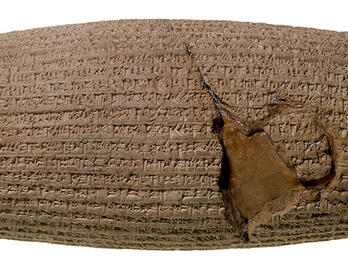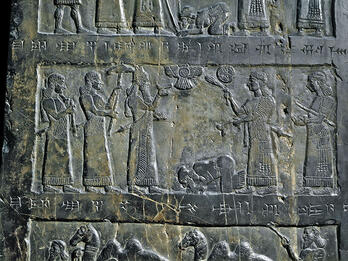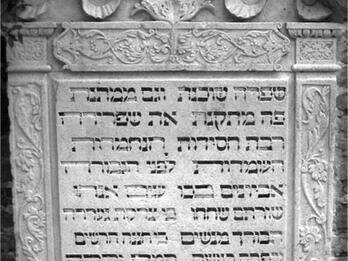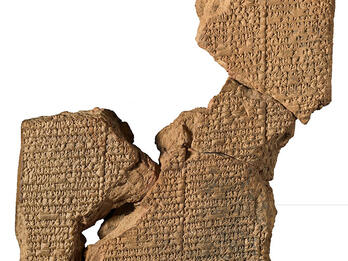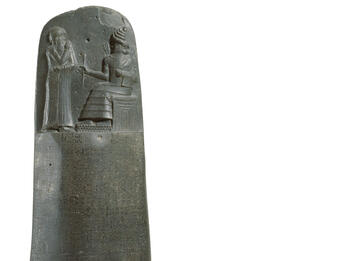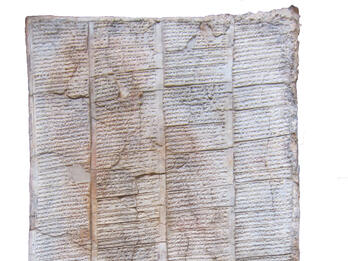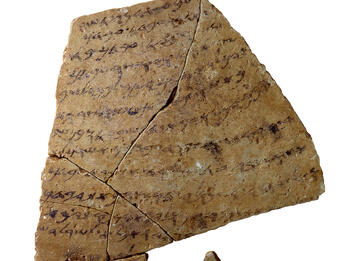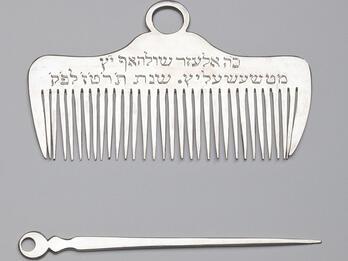Showing Results 21 - 30 of 33
Restricted
Image
Cyrus Cylinder, Babylonia. In the inscription, Cyrus, the king of Persia (reigned 559–530 BCE), declares that he was chosen by Marduk, the god of Babylon, to free its citizens from the tyranny and…
Places:
Babylon, Babylonia (Babylon, Iraq)
Date:
539 BCE
Subjects:
Categories:
Restricted
Image
The panel shown here is part of an obelisk that contains a long inscription summarizing the triumphs of the Assyrian king Shalmaneser III (r. 858–824 BCE) until the thirty-third year of his reign. The…
Places:
Calah, Assyria (Nimrud, Iraq)
Date:
859 BCE–824 BCE
Subjects:
Categories:
Restricted
Image
Tombstone of Shifra Tamari (d. 1565), Padua, Italy. In the early modern period, most Jewish tombstones in Italy were Italian Renaissance in style. Hebrew epitaph poems, like the one on this gravestone…
Places:
Padua, Venice (Padua, Italy)
Date:
1565
Subjects:
Categories:
Restricted
Text
Image
What shall the passive and lackluster do
if the pious and accomplished are swiftly felled by angels?
Quake, nations, and rich and poor fear ye the judgment day.
When the…
Places:
Padua, Venice (Padua, Italy)
Date:
1554–1705
Subjects:
Categories:
Restricted
Image
The flood story in the Atrahasis Epic, Babylonia, 17th century BCE. The epic relates the early history of humanity from creation through the flood. Apart from its polytheistic perspective, it has many…
Places:
Sippar, Babylonia (Tell Abu Habbah, Iraq)
Date:
Middle Bronze Age
Subjects:
Categories:
Restricted
Image
Laws of Hammurabi on Babylonian Stela, eighteenth century BCE. The stela was originally placed in the temple of the god Marduk in the city of Babylon. Inset shows part of the prologue.
Places:
Babylon, Assyria (Babylon, Iraq)
Date:
Bronze Age, 18th Century BCE
Subjects:
Categories:
Restricted
Image
Vassal Treaty of Esarhaddon, King of Assyria (reigned 681–669 BCE). This copy of the treaty was found in the inner sanctum of the Assyrian temple in Tell Tayinat (in southeastern Turkey), where it was…
Places:
Kinalua, Assyria (Kıyıbucak, Turkey)
Date:
Iron Age IIC, 7th Century BCE
Subjects:
Categories:
Restricted
Image
Legal complaint on ostracon, Metsad Hashaviahu, Israel, from the late 7th century BCE. A worker states that a superior took his garment despite the laborer having fulfilled his work requirements…
Places:
Meṣad Hashavyahu, Land of Israel (Yavneh, Israel)
Date:
Late 7th Century BCE
Subjects:
Categories:
Restricted
Image
Uzziah’s reinterment inscription, Jerusalem. King Uzziah (reigned 785–733 BCE) was a leper and therefore, according to the book of Chronicles, could not be buried in the royal tombs and so had to be…
Places:
Jerusalem, Land of Israel (Jerusalem, Israel)
Date:
Roman Period, 1st Century BCE or CE
Subjects:
Categories:
Restricted
Image
The process of ritual purification of a dead body, known as taharah, involves careful cleaning of the corpse. Prior to being dressed in a white cotton shroud, the body of the deceased is washed, the…
Contributor:
Artist Unknown
Places:
Bischitz, Austrian Empire (Byšice, Czech Republic)
Date:
1855–1856


